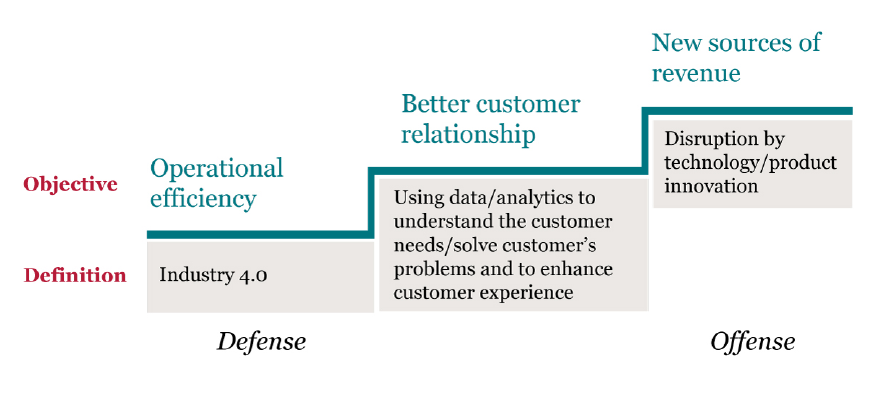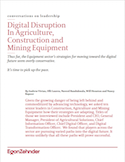Digital Disruption In Agriculture, Construction and Mining Equipment
Thus far, the Equipment sector’s strategies for moving toward the digital future seem overly conservative. It’s time to pick up the pace.
Given the growing danger of being left behind and commoditized by advancing technology, we asked ten senior leaders in Construction, Agriculture and Mining Equipment how their strategies are adapting. Titles of those we interviewed include President and CEO, General Manager, President of Agricultural Solutions, Chief Information Officer, Chief Digital Officer, and Digital Transformation Officer. We found that players across the sector are pursuing varied paths into the digital future. It seems unlikely that all these paths will prove successful.
“IoT is the antidote to commoditization of equipment and therefore it is high up in the minds of all equipment CEOs.” – General Manager, Heavy Equipment Manufacturer
Defense or Offense?
To date, most players in the Equipment sector appear to be pursuing a mostly defensive digital strategy–i.e., ensuring they advance enough technologically to protect what they have. Some are also engaged in moderately more offensive-minded strategies aimed at strengthening customer relationships. None of the executives we spoke to in the Spring of 2017 reported definitive strategies for applying Digital/IoT to create new revenue streams.
“Digital is key to driving costs down and margins up. And by building digital services into capital equipment and linking it with our service lines, we can outcompete low cost parts suppliers through value add.” – Chief Digital Officer, Industrial Machinery and Technology Company
Players who shift to more offensive strategies could gain a significant competitive advantage. There are huge opportunities to create ‘connected sites’ using sensing and monitoring technology and sophisticated analytics for ‘smart’ farming, mining, and construction. Agriculture is increasingly dominated by larger, more sophisticated businesses that are less loyal to any equipment manufacturer, but who will favor whoever contributes most to their bottom line.

Similarly, Mining companies are under intense pressure to create safer operating environments that are hyper efficient, and would surely welcome more breakthrough solutions from the Equipment sector.
“In 20 years we’ll need to produce 50% more food. Farmers also need technology to share information for compliance for environmental sustainability purposes.” – Division President, Heavy Equipment Manufacturer
Proprietary or Open Platform?
Equipment companies are choosing very different models for creating technology based advantage.
- Develop technology internally and build a proprietary platform, hoping to set the standard the rest of the industry will build on
- Engage in partnerships and encourage open platforms, recognizing it can be very difficult for OEMs to innovate on their own
The Equipment sector has a tradition of being secretive and cautious about R&D, working primarily in closed door labs. Moving to open platforms would be a leap that may prove necessary to keep pace with technological advances, although it is too soon to tell.
In any case, the sector will be challenged by customers who believe they–not the companies that make IoT enabled equipment–own operating data, even if that data is collected and aggregated by the OEM. All Equipment makers will face mounting pressures to be more open.
“For a long time, large OEMs thought they could develop the technology themselves and innovate faster than other tech providers. But we’ve seen OEMs struggle to transform themselves.” – Head of Global Business Services and CIO, Global Mining Group
Mechanical, Electrical and Digital Expertise?
Every strategy requires mechanical and electrical engineering expertise as well as cutting edge software and digital expertise. This will not be easily accomplished, as few individuals are qualified across all these disciplines. The likely solution will be to build teams that bring this expertise together.
The first step is attracting great digital talent. The Equipment company executives we interviewed recognize this will be a challenge. Salaries required to compete with Silicon Valley employers will likely feel prohibitive, and Equipment companies’ heartland locations may not appeal to young, diverse, digitally savvy technologists. Still, several of the executives we interviewed voiced optimism.
“Our edge is we can offer talent now working in Silicon Valley a chance to stand out more and have more highly visible personal impact.” – Group CIO, Construction and Agricultural Machinery Manufacturer
“As a global company with development centres across Europe, the US and in Asia, we can offer very interesting challenges and intriguing international careers. Another strength is how we treat our people. We do manage to attract quite good people.” – Digital Transformation Officer, Industrial Tool and Equipment Manufacturer
Our colleague Martha Josephson, who leads Egon Zehnder’s global Digital Media Practice from Palo Alto, has observed that some talent in Silicon Valley desires to get back into “real industry.” Observers envision Des Moines, Brisbane, Dusseldorf and other heartland cities further developing into new meccas for such types, and over time breeding a new strain of digital talent. Meanwhile, strong state university systems may prove a more productive hunting ground than the Ivy League for Equipment OEMs seeking an immediate influx of digital engineering talent.
Can Equipment Cultures Flex?
When traditional Equipment OEMs do successfully recruit established digital talent, they will face the complex challenge of acclimating people with an inherently different worldview. Market leading Equipment OEMs have proud work cultures steeped in mechanical engineering and traditional business norms. A brilliant software engineer, in contrast, may have never been asked to conform to a traditional 8-5 work day, and may assume the company will support him working from home rather than at an office. If Equipment companies hope to attract and retain such talent, something will have to give.
“We hired an engineer from Google to help create our connectivity platform. Together, we’re learning that it is not easy to bring these two worlds together.” – Division President, Agricultural and Construction Equipment Manufacturer
Most likely, the company’s culture will need to adapt even more than the people they recruit. To stay competitive, OEMs must try to eliminate the distinction between mechanical/electrical and digital talent, so that all mindsets can work seamlessly together to help their customers.
Who Will Lead?
The people at the top of Equipment companies are often the most deeply vested in tradition and established ways of working. Yet only they can lead the charge into the digital age, and time is of the essence. Customers clearly expect to realize tremendous value from advanced Digital/IoT solutions and increasingly see digital capability as a key differentiator among Equipment suppliers. Even the deepest brand loyalties may be quickly dismantled by a competitor with compelling digital advantages.
We believe the most successful Equipment OEMs will be those whose top leaders:
- Pursue “offensive” as well as “defensive” digital strategies, to make digital intrinsic to the company’s commercial model and mission.
- Actively experiment with open platforms, to mitigate the danger of miscalculation in a purely proprietary approach.
- Realize the need to work more closely with customers, suppliers and partners in a dynamic and complex stakeholder ecosystem, where collaboration and shared learning are encouraged within a safe environment.
- Sell digital talent on the idea that they can have the most impact by reshaping the future of a great Equipment company, highlighting that this is a place for them to stand out.
- Emphasize the opportunity for digital talent to create something “real” that makes a tangible difference in people’s lives.
- Rather than forcing digital talent into predefined slots, meaningfully involve them in shaping roles that will give them personal fulfillment while also delivering maximum value to the company, creatively catering to digital talent’s desires in mutually beneficial ways.
- Build teams that effectively blend mechanical and digital expertise by focusing on six critical team competencies:
- Balance: How well a team understands the importance of diversity of skills and strengths and is willing to incorporate them.
- Energy: How ambitious the team is, and how much it takes the initiative and maintains long-term momentum at a high level.
- Alignment: How well team members understand the larger team purpose, and focus their actions and those of the team on that objective.
- Resilience: How well a team can hold itself together even under severe internal or external stress and remain effective.
- Efficiency: How well a team understands the need to optimize resources and time.
- Openness: How much a team values engaging with the broader organization and the outside world and builds the connections to do so.
- Vigorously reshape the corporate culture. It is time for Equipment company CEOs to convey that the entire company must change how it works if it is to differentiate and prosper in a sector being rapidly defined by the strength of its digital technology. No one has the luxury of standing still.
The Equipment sector is hardly the first to experience technological disruption, and history provides many examples of those that ignored this reality. Few carriage makers successfully transitioned to the age of the automobile, Blockbuster fell to Netflix, and the globally dominant Nokia failed to navigate the shift from cell phone to smart phone. Strengths that served a company for decades can become irrelevant with astonishing speed. This is no time to be complacent.






